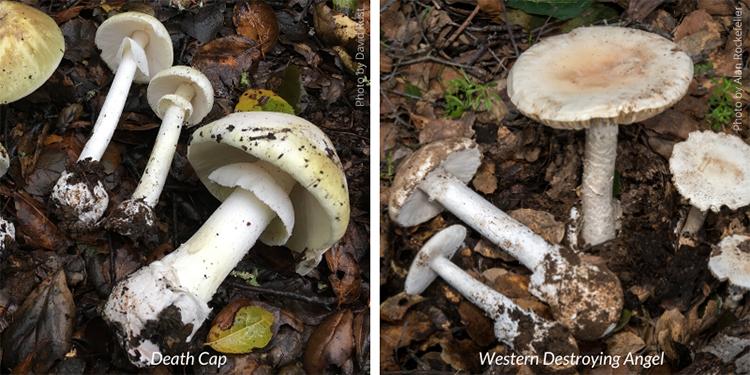Annual Wild Mushroom Warning in Parklands
With this year’s exceptionally abundant rains, Regional Parks visitors may have noticed mushrooms popping up in great numbers. Mushrooms are an ecologically important part of our parklands and can look beautiful – but some of them contain dangerous toxins. The death cap (Amanita phalloides) and western destroying angel (Amanita ocreata) are two of the world’s most toxic mushrooms, and both can be found in East Bay Regional Parks during the rainy season.
The death cap and western destroying angel mushrooms contain amatoxins, molecules that are deadly to many animals. Symptoms may not appear until up to 12 hours after consumption, beginning as severe gastrointestinal distress and progressing to liver and kidney failure if treatment is not sought immediately.
East Bay Regional Park District Naturalist Trent Pearce documents and teaches about fungi in the Bay Area. “Both of these mushrooms can be lethal to humans and pets if consumed,” Pearce warns. “They are mainly associated with oak trees and can be found growing anywhere oak roots are present.”
The death cap is a medium to large mushroom that typically has a greenish-gray cap, white gills, a white ring around the stem, and a large white sac at the base of the stem. Although the death cap is mainly associated with oak trees, it has been found growing with other hardwoods. It was accidentally introduced to North America on the roots of European cork oaks and is now slowly colonizing the west coast. The death cap is not native to California.
The western destroying angel is a medium to large mushroom that usually has a creamy white cap, white gills, a white ring around the stem that can disappear with age, and a thin white sac at the base. It fruits from late winter into spring. It is associated exclusively with oaks. Unlike the death cap, it is a native California mushroom.
“The Park District urges the public to be safe and knowledgeable about toxic mushrooms when encountering them in the parks,” said East Bay Regional Park District Public Information Specialist Jen Vanya. “Collecting any mushrooms in East Bay Regional Parks is not allowed.”
“The death cap and western destroying angel can also be dangerous for pets. Pet owners should contact a veterinarian immediately if they suspect their pet may have eaten a toxic mushroom,” added Vanya.
While the death cap and western destroying angel mushrooms are responsible for most cases of mushroom poisonings in California, deadly toxins can also be found in Galerina and Lepiota mushroom species, which also occur in the Bay Area. For more information about toxic mushrooms, visit our Toxic Mushrooms webpage.
Learn More About Fungi – Tilden Fungus Fair January 28-29
View hundreds of local mushroom specimens, mingle with the mycological community, and enjoy presentations, cooking demonstrations, mushroom art, and more at this two-day in-person special event. Saturday, Jan. 28 and Sunday, Jan. 29 from 10:00 a.m. to 4:30 p.m. Or watch from home – presentations will be live-streamed on YouTube at the 2023 Fungus Fair Live.






